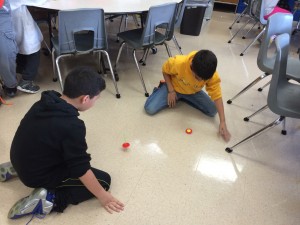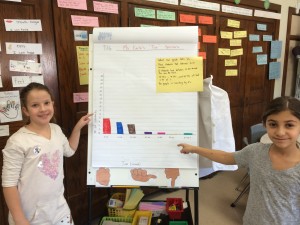Week of October 26-30
Kindergarten
Content Objective: I can demonstrate comprehension of the sense of smell by predicting various scents that I am smelling.
Language Objective: I can orally explain how I use my sense of smell to help me know what something is.
Sentence stems :
Today I smelled___________ with my nose. It smelled __________________.
Vocabulary: senses, nose, smell, scent
S.IA.00.12 Share ideas about the senses through purposeful conversation.
S.IP.00.13 Plan and conduct simple investigations using the senses
First Grade
Content Objective: I can demonstrate comprehension of changes in visible properties of objects by predicting and observing how to change the properties of yarn, clay, and colored water.
Language Objective: I can draw and label to explain how the colored water changed its color property.
Vocabulary: sort, observable, visible, properties, size, color, shape, texture, weight, thin, thick
P.PM.01.11 Demonstrate the ability to sort objects according to observable attributes such as color, shape, size, sinking or floating.
P.PM.E.1Physical Properties- All objects and substances have physical properties that can be measured.
Second Grade
Content Objective: I can demonstrate comprehension of mixtures and how they can be separated by using screens and funnels with filter paper to separate mixtures such as gravel and water, beans and pepper, and salt and water.
Language Objective: I can write to explain what a mixture is and how a mixture can be separated.
Sentence stems:
A mixture is _________________. An example of a mixture is ____________. It can be separated by _____________________________.
Vocabulary: properties, mixture, solutions, separate, size, color, shape, texture. single substance, compare, solid, liquid
P.PM.02.12 Describe objects and substances according to their properties (color, size, shape, texture, hardness, liquid or solid, sinking or floating)
P.PM.E.4 Material Composition-Some objects are composed of a single substance, while other objects are composed of more than one substance.
P.PM.02.41 Recognize that some objects are composed of a single substance(water, sugar, salt) and others are composed of more than one substance (salt and pepper, mixed beans).
Third Grade… (Continuation of last week lesson)
Content Objective: I can demonstrate application of motion by constructing a spinning top using different size disks and a shaft to describe motion and speed.
Language Objective: I can create a chart and use the data to explain how long the created “Tops” stayed in spinning motion and why?
Sentence stems:
- I made my top spin by ________________.
- I noticed that when I _________________ the top ________________________.
- I think some top’s spinned a long amount of time because_________________.
- I think some top’s spinned a short amount of time because____________________.
Vocabulary: motion, force, speed, direction, friction, disks, shaft, spinning, position, timer, seconds
P.FM.E.4 An object is in motion when its position is changing. The speed of an object is defined by how far it travels.
P.FM.03.37 Demonstrate how the change in motion of an object is related to the strength of the force acting on ii and to the mass of the object.
M.UN.03.01 Know and use common units of measurement in length, weight, and time.
Fifth Grade- (Continuation of last week)
Content Objective: I can demonstrate comprehension of Newton’s Second Law of Motion by experimenting and measuring how far cars with different masses will travel.
Language Objective: I can draw a table to show my results and explain how this activity shows Newton’s Second Law of Motion.
Sentence Stems:
The _____________ activity was an example of Newton’s Second Law of Motion.
The results from this activity showed Newton’s Second Law by _______________________.
Vocabulary: contact and non-contact forces, motion, force, mass, weight, acceleration, Newton’s Second Law of Motion, balanced force, unbalanced force, push, pull, gravitational force, relative position
P.FM.05.34 Relate the size of change in motion to the strength of unbalanced forces and the mass of the object.
P.FM.05.43 Illustrate how motion can be measured and represented on a graph.
S.IA.05.14 Draw conclusions from sets of data from multiple trials of a scientific investigation.
S.IP.05.14 Use metric measurement devices in an investigation.
S.IP.05.15 Construct charts and graphs from data and observations.
![IMG_2416[1]](https://iblog.dearbornschools.org/gruczl/wp-content/uploads/sites/1011/2015/10/IMG_24161-300x225.jpg)
![IMG_2418[1]](https://iblog.dearbornschools.org/gruczl/wp-content/uploads/sites/1011/2015/10/IMG_24181-300x225.jpg)
![IMG_2415[1]](https://iblog.dearbornschools.org/gruczl/wp-content/uploads/sites/1011/2015/10/IMG_24151-300x225.jpg)
![IMG_2413[1]](https://iblog.dearbornschools.org/gruczl/wp-content/uploads/sites/1011/2015/10/IMG_241311-300x225.jpg)
![IMG_2431[1]](https://iblog.dearbornschools.org/gruczl/wp-content/uploads/sites/1011/2015/10/IMG_24311-300x225.jpg)
![IMG_2430[1]](https://iblog.dearbornschools.org/gruczl/wp-content/uploads/sites/1011/2015/10/IMG_24301-300x225.jpg)
![IMG_2427[1]](https://iblog.dearbornschools.org/gruczl/wp-content/uploads/sites/1011/2015/10/IMG_24271-300x225.jpg)
![IMG_2424[1]](https://iblog.dearbornschools.org/gruczl/wp-content/uploads/sites/1011/2015/10/IMG_24241-300x225.jpg)
![IMG_2443[1]](https://iblog.dearbornschools.org/gruczl/wp-content/uploads/sites/1011/2015/10/IMG_24431-300x225.jpg)
![IMG_2440[1]](https://iblog.dearbornschools.org/gruczl/wp-content/uploads/sites/1011/2015/10/IMG_24401-300x225.jpg)
![IMG_2438[1]](https://iblog.dearbornschools.org/gruczl/wp-content/uploads/sites/1011/2015/10/IMG_24381-300x225.jpg)
![IMG_2437[1]](https://iblog.dearbornschools.org/gruczl/wp-content/uploads/sites/1011/2015/10/IMG_24371-300x225.jpg)
![IMG_2436[1]](https://iblog.dearbornschools.org/gruczl/wp-content/uploads/sites/1011/2015/10/IMG_24361-300x225.jpg)
![IMG_2434[1]](https://iblog.dearbornschools.org/gruczl/wp-content/uploads/sites/1011/2015/10/IMG_24341-300x225.jpg)



![IMG_2410[1]](https://iblog.dearbornschools.org/gruczl/wp-content/uploads/sites/1011/2015/10/IMG_24101-300x225.jpg)
![IMG_2328[1]](https://iblog.dearbornschools.org/gruczl/wp-content/uploads/sites/1011/2015/10/IMG_232811-300x225.jpg)
![IMG_2325[1]](https://iblog.dearbornschools.org/gruczl/wp-content/uploads/sites/1011/2015/10/IMG_232511-300x225.jpg)
![IMG_2423[1]](https://iblog.dearbornschools.org/gruczl/wp-content/uploads/sites/1011/2015/10/IMG_24231-300x225.jpg)
Leave a Reply